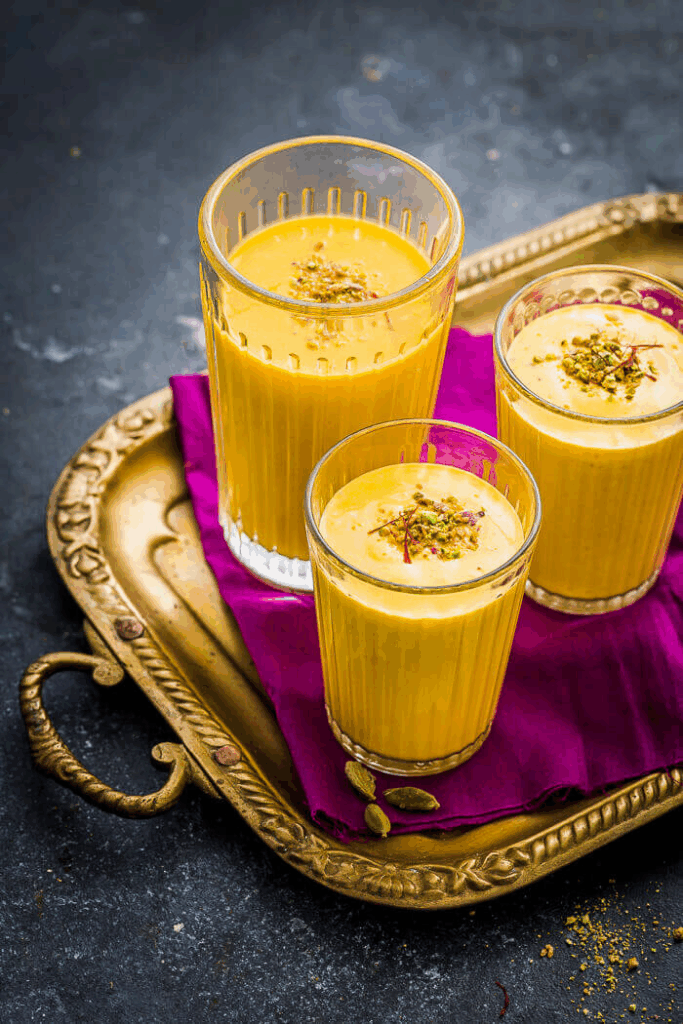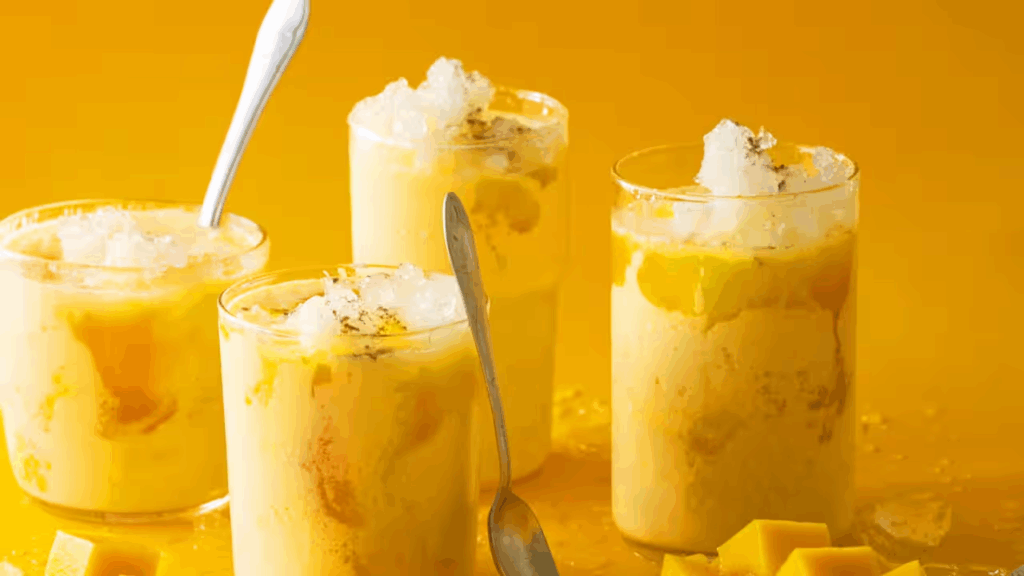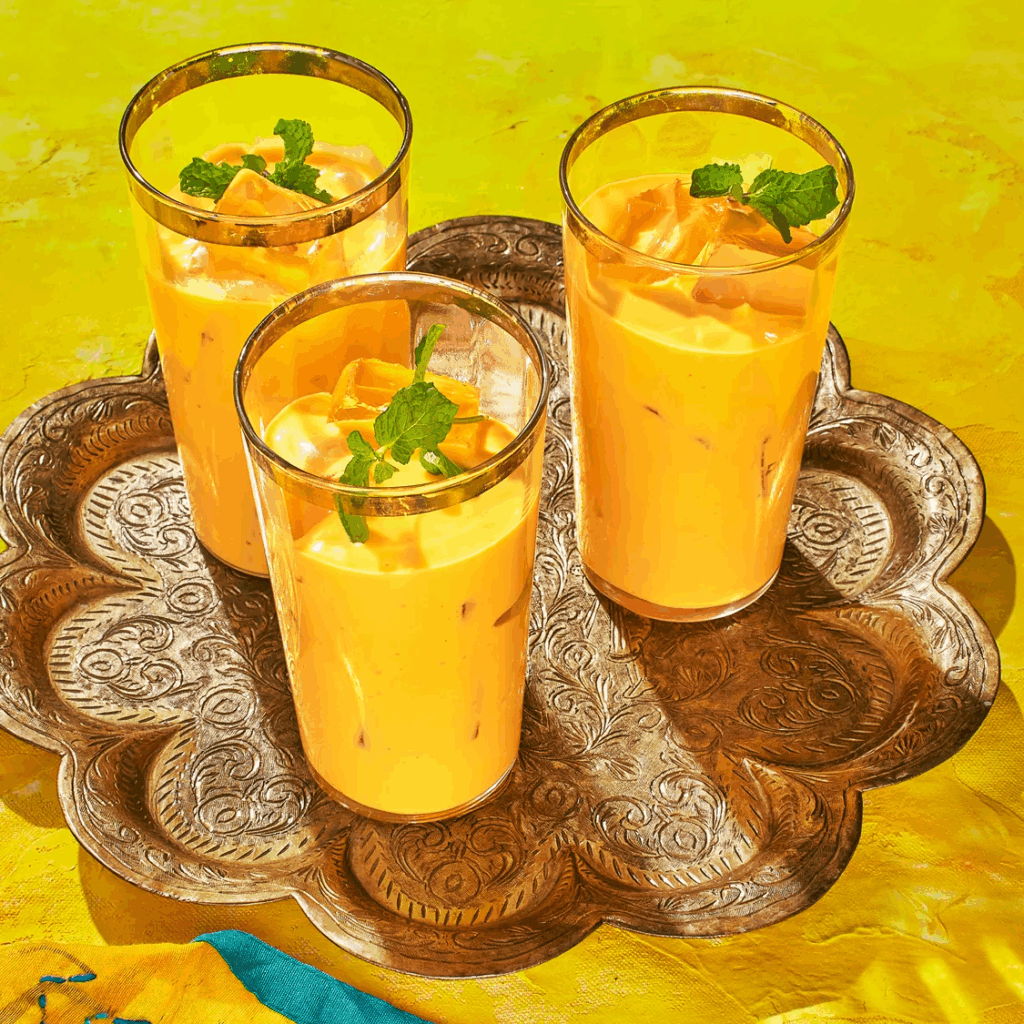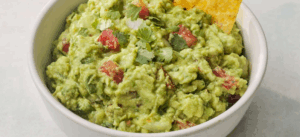Easy Indian Mango Lassi Recipe: From a Chef’s Kitchen

As someone who has worked in both Indian restaurants and international kitchens, I’ve made mango lassi more times than I can count—each time tweaking it for the perfect flavor and texture. This chilled, creamy yogurt-based drink is more than just a dessert—it’s a refreshing balance to spicy meals and a nostalgic sip of summer. In this guide, I’ll walk you through everything I’ve learned about mango lassi: how to pick the right mangoes, blend textures, and even add exciting twists. Whether you’re new to Indian drinks or refining your technique, this one’s for you.
- What Is Mango Lassi and Why It’s Loved in Indian Cuisine
- Essential Ingredients for a Perfect Mango Lassi
- Best Time and Occasion to Serve Mango Lassi
- Choosing the Right Mangoes for Lassi
- Preparing Mango Lassi with Fresh, Frozen, or Canned Mangoes
- Techniques for Blending: From Home Blenders to Restaurant Blenders
- Sweeteners and Their Alternatives: From Sugar to Dates
- Variations of Mango Lassi: Classic, Spiced, Vegan, and Dessert-Style
- Pairing Mango Lassi with Meals: What Works Best
- Cooking Mango Lassi: Microwave, Oven, and Slow Cooker Variants
- Texture Control: Thick, Pourable, or Frothy
- Flavor Infusions: Saffron, Rosewater, Mint, and More
- Make-Ahead and Storage Tips for Mango Lassi
- Serving Styles: Street-Style, Restaurant-Style, and Home Comfort
- Common Mistakes When Making Mango Lassi
- Nutrition and Benefits of Mango Lassi
- FAQ: Easy Indian Mango Lassi Recipe

What Is Mango Lassi and Why It’s Loved in Indian Cuisine
Mango lassi is a sweet, tangy, and deeply satisfying yogurt drink made by blending ripe mangoes with yogurt, a bit of sugar, and often cardamom. It’s popular across the Indian subcontinent and now beloved worldwide. From my own culinary travels, I’ve seen it served everywhere from roadside stalls in Delhi to high-end brunches in London.
In India, it’s not just a drink—it’s a cooling agent during hot summers, a digestive aid after spicy meals, and sometimes even a light dessert. What sets mango lassi apart from other smoothies is the balance of fruit, dairy, and spice, all without feeling heavy.
Essential Ingredients for a Perfect Mango Lassi
When I make mango lassi, I focus on three pillars: the fruit, the yogurt, and the balance. Here’s what I use in my base recipe:
- Mangoes: Alphonso is king. But if you’re outside India, Ataulfo or Kent are great. I avoid canned pulp unless it’s Kesar brand or a trusted Indian supplier.
- Yogurt: Full-fat plain yogurt gives the best texture. Greek yogurt works too, though I thin it with a bit of milk.
- Sugar: Depends on the mango’s sweetness. I start small and adjust.
- Cardamom: Just a pinch adds floral warmth.
- Ice or chilled water: To bring down the temperature and lighten the texture.
Some chefs add rosewater or saffron—I’ll cover those in the variations.

Best Time and Occasion to Serve Mango Lassi
| Occasion | Ideal Serving Time | Notes |
| With spicy meals | Lunch (12–2 PM) | Cools the palate after strong curries |
| As a summer refreshment | Afternoon (2–4 PM) | Hydrating and calming |
| Alongside Indian breakfasts | Morning (8–10 AM) | Pairs well with light dishes like Poha (вставить ссылку на How to prepare Indian Poha breakfast) |
| As a dessert | Evening (after 7 PM) | Add saffron or cream for a richer version |
| During fasting or detox days | Anytime | Use honey and Greek yogurt for balance |
In my own experience, serving mango lassi chilled—just above 5°C—is crucial for peak enjoyment.
Choosing the Right Mangoes for Lassi
This part is everything. A good mango can make the lassi luscious and fragrant; the wrong one can ruin it. I always look for mangoes that are slightly soft to the touch and smell sweet at the stem.
When I lived in Mumbai, Alphonso mangoes spoiled me. Outside India, I rely on Ataulfo or Champagne mangoes—never Tommy Atkins, which are fibrous and flavorless. If it’s off-season, I reach for frozen chunks or a trusted can of Alphonso pulp. But I always blend, then strain, to keep it smooth.
You can also test your mango with a spoon—if the pulp scoops out like butter, it’s ripe enough for lassi.
Preparing Mango Lassi with Fresh, Frozen, or Canned Mangoes
I’ve worked with all three depending on season, region, and client needs—and each one needs a slightly different touch.
Fresh mangoes are ideal. They offer the brightest flavor, but only if ripe. I peel, chop, and chill the mango before blending. When they’re perfect, I barely need sugar.
Frozen mango chunks work wonderfully too, especially for batch prep. I let them thaw slightly before blending to avoid overworking the motor and use a splash of warm milk to start the blades.
Canned pulp, especially Alphonso pulp from India, is my off-season savior. It’s concentrated and smooth. I usually dilute it a bit and reduce added sugar since it’s often pre-sweetened.

Techniques for Blending: From Home Blenders to Restaurant Blenders
When I make mango lassi in a professional kitchen, I use high-powered Vitamix or Blendtec blenders to get that creamy, almost mousse-like texture. But at home, a regular blender works too—you just have to layer the ingredients right.
I start by adding liquid at the bottom (milk or yogurt), followed by mango, then sugar and spices. This order prevents jamming. Ice or frozen mango goes in last so it stays at the top and doesn’t trap the blades.
Always blend in short pulses first, then let it run until silky smooth. If you’re not sure, strain it through a fine mesh once blended—it makes a huge difference for presentation.
Sweeteners and Their Alternatives: From Sugar to Dates
Personally, I use fine white sugar for classic mango lassi—it dissolves easily and doesn’t interfere with flavor. But I’ve experimented a lot for clients with dietary restrictions or preferences.
- Honey: Adds floral sweetness and blends well. Great with Greek yogurt.
- Maple syrup: Subtle but too woody for some mangoes.
- Jaggery syrup: Earthy and traditional—best with canned mango pulp.
- Dates: Soaked Medjool dates add richness and nutrition. I use this option for diabetic-friendly lassi.
The key is balance. A good mango lassi should taste like mango first—sweetness should follow, not dominate.
Variations of Mango Lassi: Classic, Spiced, Vegan, and Dessert-Style
In my kitchens, I’ve prepared more than a dozen twists on mango lassi to suit tastes from kids to gourmet palates. Here are the most requested:
- Classic mango lassi: Yogurt, mango, sugar, cardamom.
- Spiced lassi: Add ginger or a hint of black pepper for warmth.
- Vegan mango lassi: Use coconut yogurt and almond or oat milk. Dates work well as a sweetener here.
- Dessert lassi: Top with whipped cream, saffron strands, or chopped pistachios. I once served this after Idli and sambar at a fusion dinner—unexpected, but delicious. (вставить ссылку на How to make Idli and sambar at home)
- Mint mango lassi: Blend in a few fresh mint leaves. It’s popular at summer outdoor events I cater.
I’ll go deeper into serving ideas and pairings soon, especially how it matches beautifully with Indian Pulao rice.

Pairing Mango Lassi with Meals: What Works Best
From my experience, mango lassi isn’t just a drink—it’s part of a complete dining experience. I usually pair it with dishes that have a strong spice profile or light savory flavors. For example:
- It balances out spicy dishes like chicken vindaloo, lamb rogan josh, or paneer tikka.
- It complements How to make Indian Pulao rice (вставить ссылку) with a refreshing contrast.
- It softens the flavors of fried appetizers like samosas or pakoras.
- It refreshes after a breakfast like Idli and sambar or Poha.
- For guests sensitive to spice, I serve mango lassi before the main meal as a palate primer.
Serving mango lassi cold—around 5–7°C—is something I always emphasize. Too warm, and it feels heavy. Too icy, and the texture gets diluted.
Cooking Mango Lassi: Microwave, Oven, and Slow Cooker Variants
Yes, mango lassi is a drink—but I’ve had to adapt it for different events where texture and warmth matter. Here’s how I’ve handled it using non-traditional techniques:
- Microwave: I’ve gently warmed a mango lassi base for winter events. A quick 15–20 second zap (no ice, of course) turns it into a warm yogurt drink. Add saffron or cinnamon for comfort.
- Oven: Surprisingly, I’ve baked a thickened mango lassi (with corn flour or agar) in ramekins as a dessert. It sets into a custard-like texture and pairs well with pistachios.
- Slow cooker: I’ve used it to reduce mango lassi slowly into a creamy sauce for desserts—think mango rabri.
These aren’t traditional, but if you’re hosting an experimental brunch or buffet, they add creativity that guests love.
Texture Control: Thick, Pourable, or Frothy
Texture is everything in mango lassi. I always ask clients if they prefer it:
| Desired Texture | Ingredient Adjustment | Serving Tip |
| Thick and spoonable | Use full-fat Greek yogurt + chilled mango, no ice | Serve in bowls with saffron on top |
| Smooth and pourable | Regular plain yogurt + splash of milk or water | Classic restaurant style |
| Frothy and airy | Blend with crushed ice or use a handheld milk frother | Great for summer events or buffets |
I personally lean toward the smooth, pourable style for its versatility. But when I’m preparing mango lassi for dessert courses, the thick version with saffron always impresses.
Flavor Infusions: Saffron, Rosewater, Mint, and More
I often enhance mango lassi with subtle aromatics depending on the occasion. These small additions take it from everyday to festive:
- Saffron: Steep a few strands in warm milk before adding to the blend. This is my go-to for weddings or formal dinners.
- Rosewater: A few drops go a long way—too much can overpower. Perfect for pairing with almond-based dishes.
- Mint: Refreshing and summer-friendly. I blitz it with the mango for a cool green hue.
- Lime zest: For a tangy twist, I’ve grated in lime peel—it brightens up overly sweet batches.
- Vanilla or cinnamon: When I’m making mango lassi for kids, a tiny splash of vanilla smooths out the flavor beautifully.
These enhancements are especially welcome when you’re serving a multi-course Indian meal where you want your drink to stand out, not just cool down.
Make-Ahead and Storage Tips for Mango Lassi
When preparing mango lassi for a large brunch or catering event, I often make it a few hours ahead. In my experience, letting it chill in the fridge actually helps deepen the flavor and thicken the texture slightly. I always store it in a tightly sealed glass jug to maintain freshness and prevent the yogurt from absorbing fridge odors.
It’s completely normal for the drink to separate over time. I simply stir it gently before serving—it returns to a perfect creamy balance. I’ve also tried freezing mango lassi into ice cubes, which works surprisingly well when I want to keep the drink cool without watering it down. If you’re serving it buffet-style, that little trick can make a big difference.
Freezing the entire lassi batch, however, changes the texture. I’ve done it a few times during travel prep, and while it’s still delicious, it turns slightly grainy. If I must freeze it, I let it thaw partially and then reblend just before serving.
Serving Styles: Street-Style, Restaurant-Style, and Home Comfort
How I present mango lassi really depends on where I’m serving it. For food festivals and street-food themed events, I love using traditional metal cups or clay kulhads—it instantly creates a nostalgic connection and people appreciate the authenticity. At more formal settings, like restaurant dinners or weddings, I go with tall glasses and finish each drink with a swirl of saffron or a few pistachio crumbs on top. It looks elegant and elevates the experience.
At home though, things are different. I’ve poured mango lassi into everything from coffee mugs to mason jars, depending on what’s available. What really matters to me is not the container, but the chill. A properly cooled lassi, slightly thick, with just a hint of cardamom—that’s the kind of comfort I enjoy most, especially after a traditional Indian Poha breakfast.
Common Mistakes When Making Mango Lassi
I’ve taught dozens of students and assistants how to make mango lassi, and I can tell you—some errors come up again and again. The most common one? Using mangoes that aren’t ripe enough. If your mango isn’t naturally sweet, no amount of added sugar will fix the lack of flavor. I always taste the mango first, then adjust the yogurt and sweetness accordingly.
Another issue I often correct is over-blending. People think they need to run the blender for a full minute or more, but that just adds air and thins out the drink. A few pulses are all it takes. And don’t ignore the yogurt—if it’s too sour, your lassi will be off. I prefer using plain full-fat yogurt or Greek-style for consistency.
Many people also forget that a tiny pinch of salt or cardamom can transform the drink. Without it, even a well-balanced lassi can feel flat. The smallest details often make the biggest difference.
Nutrition and Benefits of Mango Lassi
I’ve had health-conscious clients ask whether mango lassi is just a dessert in disguise. But when prepared with balance, it’s far from that. Yogurt provides probiotics and calcium, helping with digestion and gut health. Mango, especially when fresh and not over-sweetened, brings in fiber, vitamin A, and vitamin C.
I also add cardamom not just for aroma, but for its digestive properties—it calms the stomach and balances sweetness. A small touch of saffron adds anti-inflammatory benefits and a sense of luxury, especially if I’m pairing it with something indulgent like Korma curry .
When enjoyed after a hearty meal or spicy dish, mango lassi can genuinely support digestion while offering a soothing, cooling effect. For me, it’s one of the rare drinks that brings together nourishment, tradition, and flavor in one perfect glass.
FAQ: Easy Indian Mango Lassi Recipe
What’s the best mango variety for lassi?
From my experience, nothing beats Alphonso mangoes for lassi. Their natural sweetness, rich color, and smooth pulp make them ideal. If Alphonso isn’t available, I’ve also used Ataulfo or Kesar mangoes with great results. The key is to go for ripe, juicy fruit with low fiber content.
Can I make mango lassi without yogurt?
I’ve experimented with vegan versions using coconut or almond yogurt, and they do work surprisingly well. While the texture is a bit thinner, the flavor still holds up. If you’re lactose-intolerant, I definitely recommend coconut yogurt—it pairs beautifully with mango.
Is it okay to use canned mango pulp?
Yes, and I’ve done this many times when mangoes are out of season. Canned pulp, especially Alphonso pulp, can be very good quality. Just make sure to check the sugar content—some are pre-sweetened, so adjust your recipe accordingly.
How do I keep the lassi from separating?
On my catering gigs, I usually chill lassi in sealed containers and give it a quick shake before serving. If you blend it just enough and use full-fat yogurt, separation is minimal. Over-blending introduces air and causes quicker separation.
What spices go best with mango lassi?
I always use cardamom—it adds warmth and balances sweetness. A touch of saffron adds elegance. I’ve also tried rosewater and even a bit of ground ginger in winter for a warming twist. But keep it subtle—mango should always be the star.
How sweet should the lassi be?
I recommend tasting as you go. Some mangoes are naturally very sweet, so you won’t need much sugar or honey. I usually start with a teaspoon of honey and adjust. On my own palate, I prefer it less sweet when serving with dishes like Indian Pulao rice.
Can I use frozen mango chunks?
Absolutely. I’ve used frozen mango many times, especially for chilled lassi on hot days. It gives the drink a thicker, smoothie-like texture. Just make sure to thaw slightly or use a high-speed blender for best results.
Is it a drink or a dessert?
I see it as both. In homes across India, it’s served during meals to balance spice. But in restaurants, I’ve served mango lassi as a dessert topped with pistachios or saffron. Either way, it’s deeply satisfying.
Can I add protein to mango lassi?
Yes. When I need to bulk it up, I add a spoonful of protein powder—usually unflavored or vanilla. Greek yogurt naturally adds protein, so if you’re looking for a post-workout drink, mango lassi can be a tasty choice.
Why does my lassi turn sour?
This usually comes from overly sour yogurt or storing it too long. I always check the yogurt’s freshness before blending. Also, use chilled mango and serve soon after making—it helps maintain a clean, fresh taste.
Can I serve it with savory dishes?
Definitely. I often serve mango lassi alongside spicy curries or breakfast items like Idli and sambar. It cools the palate and complements heat beautifully. Just keep the lassi slightly less sweet for balance.
What’s the difference between lassi and a smoothie?
I’ve been asked this often. Smoothies typically use ice and multiple fruits, while lassi is yogurt-based and rooted in Indian culinary tradition. The texture of lassi is smoother, and its flavor is more refined and focused.
Can I add toppings to make it fancier?
Yes, and I do that all the time in restaurant settings. Sliced pistachios, rose petals, saffron strands, or even a dusting of cardamom can elevate the drink. Presentation goes a long way, especially if you’re entertaining.
Does it need to be chilled before serving?
Always. I’ve found mango lassi is best when served cold—not frozen, but nicely chilled. Letting it sit for 30 minutes in the fridge after blending really helps develop the flavors.
How long can I store it in the fridge?
From my experience, it keeps well for up to 48 hours if sealed tightly. Beyond that, the texture and flavor can suffer. I usually prepare just enough for one to two days, and fresh batches always taste better.




Post Comment